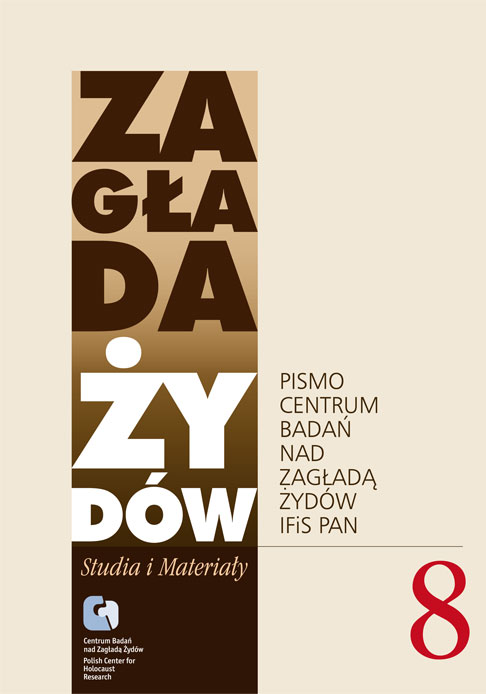Pogłoski w białostockim getcie. Przyczynek do historiografii Zagłady z perspektywy żydowskiej
Zagłada Żydów. Studia i Materiały, Nr 8 (2012), Strony: 214-236
Data zgłoszenia: 2020-10-28Data publikacji: 2012-12-02
 https://doi.org/10.32927/ZZSiM.633
https://doi.org/10.32927/ZZSiM.633
Abstrakt
The article deals with rumors, which were circulated in the Białystok ghetto. It seems that a rumor is a form of collective interpretation of reality whose function is to structure equivocal situations by explaining events or predicting them. The mood and behavior of individuals and groups may be influenced by rumors, in particular if they find themselves – as the Jews in the ghettos – in an exceptional and lifethreatening situation characterized by insecurity, isolation and uncertainty. The article analyzes rumors relating to the deportations of Jews from the ghetto and German mass murder actions. It addresses the following questions: Which impact did the different rumors have? How did the Judenrat and the ghetto population react to them? The article demonstrates that Jews acted upon their apprehension or misapprehension of events and that their subjective evaluation of the German extermination policy influenced their behavior and decisions
Słowa kluczowe
pogłoski , deportacje , niemiecka polityka eksterminacyjna , Judenrat , żydowska perspektywa i zachowania
Licencja
Prawa autorskie (c) 2012 Autor & "Zagłada Żydów. Studia i Materiały"

Utwór dostępny jest na licencji Creative Commons Uznanie autorstwa 4.0 Międzynarodowe.
https://creativecommons.org/licenses/by/4.0
Podobne artykuły
- Jan Grabowski, Dariusz Libionka, Bezdroża polityki historycznej. Wokół Markowej, czyli o czym nie mówi Muzeum , Zagłada Żydów. Studia i Materiały: Nr 12 (2016)
- Dariusz Libionka, Jan Grabowski, Meldunki Obwodu „Praga” Policji Polskiej o zatrzymaniach Żydów w Warszawie w okresie maj–lipiec 1943 r. , Zagłada Żydów. Studia i Materiały: Nr 10 (2014)
- Adam Sitarek, W obliczu „trudnej konieczności”. Administracja żydowska getta łódzkiego wobec wsiedleń Żydów z Rzeszy i Protektoratu (październik–listopad 1941 r.) , Zagłada Żydów. Studia i Materiały: Nr 8 (2012)
- Bożena Szaynok, Po Zagładzie. Przed Soborem. Obraz Żydów w listach do „Tygodnika Powszechnego” po publikacji artykułu Jerzego Turowicza Antysemityzm (marzec 1957) , Zagłada Żydów. Studia i Materiały: Nr 19 (2023)
- Martyna Grądzka-Rejak, Zoë Waxman, Kobiety Holocaustu , Zagłada Żydów. Studia i Materiały: Nr 16 (2020)
- Dariusz Libionka, Walka i propaganda. Powstanie w getcie warszawskim z perspektywy polskiego Londynu , Zagłada Żydów. Studia i Materiały: Nr 10 (2014)
- Agnieszka Haska, „Zbadać i wyświetlić”. Centralna Żydowska Komisja Historyczna (1944–1947) , Zagłada Żydów. Studia i Materiały: Nr 13 (2017)
- Dariusz Libionka, The Fighting and the Propaganda: The Uprising in the Warsaw Ghetto from the Perspective of ‘Polish London’ , Zagłada Żydów. Studia i Materiały: Nr Holocaust Studies and Materials (2017)
- Marcin Zaremba, „Ta cała banda żydowska zdechła nareszcie”. Eksterminacja Żydów w listach żołnierzy niemieckich z 1942 r. , Zagłada Żydów. Studia i Materiały: Nr 10 (2014)
- Katarzyna Kuczyńska-Koschany, Erntefest – od etymologii do zastosowania , Zagłada Żydów. Studia i Materiały: Nr 15 (2019)
<< < 1 2 3 4 5 6 7 8 9 10 11 12 13 14 15 16 17 18 19 20 21 > >>
Możesz również Rozpocznij zaawansowane wyszukiwanie podobieństw dla tego artykułu.
 English
English
 Język Polski
Język Polski








